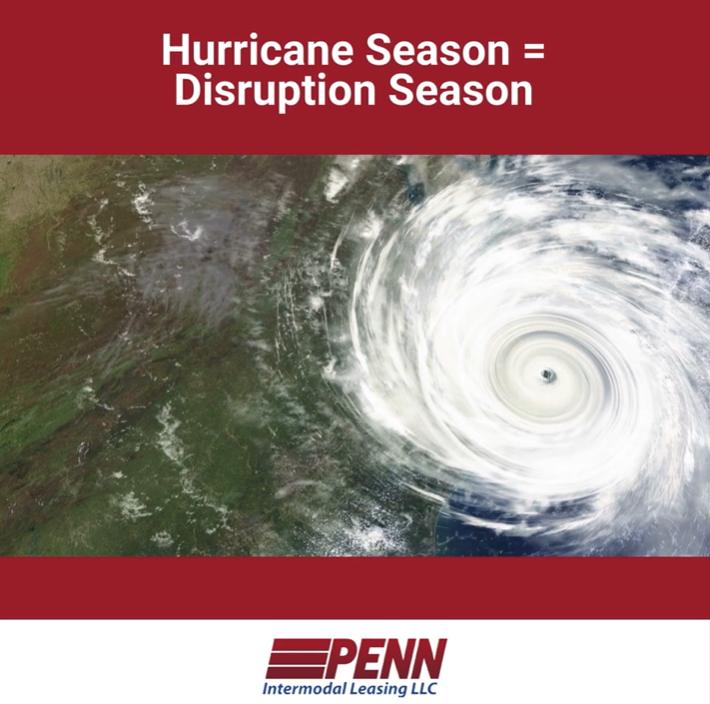
June 1st through November 30th is the busiest season for the transportation industry due to high shipping volumes for back-to-school, the fall harvest, preparation for holiday shopping, and online direct-to-consumer sales. It also coincides with hurricane season and drought / fire season, and it is closely followed by winter storm season depending on what part of the country you are in.
Extreme weather events present challenges to transportation logistics companies. Since 2020, six tropical systems have made landfall on the Texas coastline. Hurricane Nicholas (a Category 1 storm which made landfall in September 2021 weeks after Hurricane Ida) dropped 6 to 16 inches of rain throughout the Houston, TX area and lowered Lake Houston by one foot. The Great Texas Freeze, which occurred over a ten-day period in February 2021, amounted to a $24-billion dollar natural disaster from catastrophic cold weather and blackouts across the state. In addition to weather disasters, the logistics industry must navigate aging infrastructure and unexpected transportation route disruptions, such as the collapse of the Francis Scott Key Bridge in Baltimore, MD in March 2024 which occurred when a Singapore-based container ship lost power and struck the bridge abutment and the tanker fire which closed a section of I-95 in Philadelphia, PA in 2023. Road closures from smoke and wildfires also require alternate transportation routes.
Extreme weather conditions and transportation disruptions, some predictable and some not, make planning and preparation key for companies involved with transporting bulk liquid products. Particularly companies that specialize in chemicals or food-grade products which have specific requirements for shipping, require modifications to chassis and / or ISO tank containers, and time constraints in order to prevent loss of quality or spoilage.
The companies that are successful at managing known challenges, have risk management and contingency plans in place for unexpected disruptions, and have established relationships within the industry will meet customer delivery schedules and exceed customer expectations most often, and have a competitive advantage.
Expect Decrease in Chassis and Equipment Availability After a Hurricane
Following a major hurricane, ports and depots may experience severe damage to roads, bridges, buildings, and other infrastructure. Equipment such as trailers, chassis, and cranes may sustain damage from falling debris or result in a complete loss from water damage and flooding. In addition, trucks and heavy-duty vehicles which did not sustain damage may be diverted from their regular duties in order to assist with emergency relief efforts such as providing water, food and building supplies to hard-hit areas. Power outages and fuel shortages may slow response and recovery efforts.
Warehouses, depots, and fulfillment centers in affected areas may be forced to temporarily shut down or may be inaccessible. Road closures from flooding as well as downed trees and power lines may linger long after the initial storm passes, slowing the rebuilding efforts and making routine pick-ups and deliveries impossible. Regional centers and neighboring facilities will accommodate some of the overflow, but these centers can also reach capacity and become over-crowded resulting in traffic congestion delays which further compound equipment shortages.
Logistics and Transportation Prices Jump Following a Hurricane
A shortage of equipment inventory, longer distances between pick-up and delivery locations, longer idle and wait times from congestion at locations which are open and operational can increase rental prices on equipment. For example, there was a sudden shift in supply and demand for chassis and transportation equipment following Hurricane Harvey. DAT Solutions reported that spot market truckload rates increased by 6% points. In addition, these higher costs were compounded by the higher cost of fuel following the hurricane.
Texas is home to nearly 30% of U.S. petroleum refineries, most of which were shut down at least temporarily by Hurricane Harvey. CNN reported that the national cost of gas had spiked by 15% in the wake of Harvey and had continued to rise in the following months. These increases in transportation costs following hurricanes and natural disasters impact both the transportation industry, distributors, and outlets that rely on lower shipping costs and fuel prices to maintain healthy profit margins.
Bulk Liquid Transportation Hurricane Logistics Planning
When reflecting on major storms and the damage they leave behind, it brings to the forefront the need for manufacturers, drivers, logistics and transportation industry personnel to be prepared.
For these professionals, “preparedness” for hurricanes should include:
- Documentation and training on risk management, contingency and communication plans to keep your team informed of closures, changes to routes and adjustments to operations as the need arises.
- Updating insurance policies to include damage from flooding and hurricanes on property and equipment.
- Paying close attention to advanced weather warnings and road conditions and acting in a timely manner.
- Quickly transporting assets out of harm’s way when the need arises.
- Maintaining equipment properly so that it is available and operational.
- Have relationships with a support team which includes logistics personnel and a chassis leasing partner to replace damaged equipment in an emergency.
Transportation Industry Preparing for Hurricane Season
Hurricanes, winter storms, and man-made accidents result in immediate and longer-term disruptions to the smooth transportation of freight, bulk liquids and goods. Following these events, it takes time for organizations to reorganize, reroute and restore normal operations. A crucial part of logistics planning is the cultivation of strong relationships. Establishing a relationship with a reliable chassis leasing company offers benefits such as:
- Streamlined transactions due to prior approval of insurance and financials.
- A trusted supplier of durable, quality equipment.
- Low capital requirements.
- Flexible lease terms.
- Depot and industry relationships.
With over 30+ years in business, Penn Leasing has assisted numerous customers with resolving equipment supply issues. At Penn Intermodal Leasing, we understand that efficient bulk liquid transport and storage is a key component of your business. Don’t wait for an emergency, contact Penn Intermodal Leasing today for more information!
A side note:
Climate Change is Expected to Worsen the Frequency and Intensity of Extreme Weather Events
According to NOAA, every month in 2023 ranked among the seven warmest for that month of the year in terms of global temperatures. In addition, every month from June through December was the hottest on record for that month. According to the Center for Climate and Energy Solutions, if global average temperatures continue to rise, the severity and incidents of extreme weather events like hurricanes, tornadoes, wildfires, droughts, extreme heat/cold, and extreme precipitation will increase. Severe weather often brings damage to infrastructure which results in delays and disruptions in the transportation industry and supply chains, so it pays to be prepared.
The transportation industry is currently responsible for 29% of the nation’s total greenhouse gas emissions, making it the largest single contributor on record. The U.S. EPA and U.S. DOT have developed progressively stricter standards for cars and trucks to reduce carbon emissions and move the country towards fuel sources with lower carbon emissions. These standards include requirements for greater fuel efficiency, hybrid, and electric vehicles, and will reduce America’s dependence on oil.
The EPA’s SmartWay program helps transportation businesses find the most efficient supply chain routes, identifying ways to reduce fuel costs and greenhouse gas emissions. For years, the EPA has required that automakers display fuel economy, fuel costs, as well as ratings on greenhouse gas and smog-forming pollutants on their vehicles. The SmartWay program now supplies information on cars and trucks with the best fuel economy and lowest emissions to help transportation companies make environmentally informed investments.
Although the transportation industry currently contributes the largest amount of greenhouse gas emissions to the total emissions of the U.S., many businesses have started to take steps to decrease that number. By reducing the number of miles needed to travel, upgrading vehicle technologies, using low-carbon fuel, and operating vehicles more efficiently, transportation businesses are attempting to offset climate change and reduce the amount of extreme weather events that have become more frequent.
SOURCES:
- “Carbon Pollution From Transportation” EPA, Environmental Protection Agency, 8 June 2021.
- Douglas, Erin & Fechter, Joshua, “Texas sees limited damage in wake of Tropical Storm Nicholas as storm weakens and takes aim at Louisiana.” The Texas Tribune, https://www.texastribune.org/2021/09/14/texas-hurricane-nicholas-tropical-storm/ Accessed 19 Apr. 2024.
- “Extreme Weather and Climate Change..” Center for Climate and Energy Solutions, Center for Climate and Energy Solutions, Accessed 19 Apr. 2024.
- Finley, Ben & Pollard, James. “What we know about the Baltimore bridge collapse.” AP News, Accessed 19 Apr. 2024.
- Lindsey, Rebecca & Dahlman, Luann. ” Climate Change: Global Temperature.” NOAA Accessed 19 Apr. 2024.
- NCEI.Monitoring.Info@noaa.gov. “Global Climate Report – Annual 2021.” Global Climate Report – Annual 2021 | National Centers for Environmental Information (NCEI), 23 Jan. 2022.
- Oberholtz, Chris, “On this day: The Great Texas Freeze began and would rank among worst winter storms in history.” Fox Weather, Accessed 19 Apr. 2024.
- “Transport.” UN Environment Programme, Accessed 19 Apr. 2024.

